ARM® Technology Drives Wearable Innovation
by Kinjal Dave, Product Manager for High Efficiency Cortex-A CPUs at ARM.
2014 has truly been the year of the wearable, with many big-name manufacturers releasing their first, second and even third generation devices.
The market for these devices has proven to be fast-paced and highly innovative over the past three or four years, with a number of early stage start-up companies competing with some of the multinational technology companies. On top of this, we have seen companies explore different types of wearable device, giving the market added diversity. Smartglasses, smartwatches, activity trackers, wearable computers and wearable cameras are just a few of the types of wearable devices which have emerged as a part of the wider market, demonstrating the vast growth potential of the technology. This flexibility of form factor will further drive innovation and growth over the coming months and years.
Given the range of different wearables types, sizes, manufacturers and processing requirements, one of the sole constants within the market is the presence of ARM technology. ARM’s low-power technology has proven to be the right fit for wearables, with adjustable processor configurations allowing wearable devices to use the same basic SoCs as other mobile devices but at a lower frequency. By the end of 2014, IDC estimates that 19.2m wearable devices will have been shipped, and the vast majority of these will have ARM processors within them. ARM’s presence owes much to its range of pervasive architectures and processor designs and supporting ecosystem which means that there is a highly suitable and most complete solution to every need. With 240 licenses issued for Cortex-M based products, 178 for Cortex-A (October 2014), and over 3,000 catalogue MCU parts based on Cortex-M, ARM is the trusted choice for CPUs of all sizes, and ARM partners are continuing to produce the components within the best wearable devices.
In this first part of our wearable device review, we will look at some of the devices which have driven innovation in different sections of the market since the wearable revolution begun. While these products have seen successors, these products have undoubtedly been trendsetters, paving the way to new devices with even more advanced technology.
Fitbit Flex: ARM Cortex-M3
One of the devices which helped to drive the uptake of wearables in 2013 was the ARM-based Fitbit Flex. Activity trackers such as the Flex have proven to be immensely popular amongst consumers. The overall market for optimized health tracking devices was estimated to be worth $330m last year. This market demonstrated that commercially successful devices do not necessarily need to have huge feature-sets, instead offering accurate and well-defined tracking capabilities alongside a user-friendly battery life.
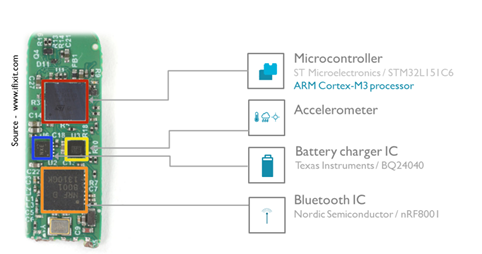 |
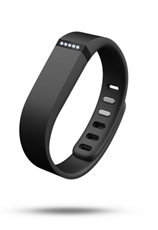 |
Tech news magazine Wired describes the device as “the most wearable, best-syncing device in the scrum, with the best app to boot”. The Flex monitors key statistics about your daily activity levels, including steps taken and calories burned, and also monitors sleep quality. It then wirelessly synchronizes this data automatically to a USB Dongle which plugs into your computer, and directly to your phone via Bluetooth Low-Energy.
This is in part thanks to the low-power ARM Cortex-M3 based microcontroller inside the device, which acts as an ‘always-on, always-aware’ processor. The Cortex-M3 is one of the most popular 32-bit MCUs ever and running at just 32MHz, it is specifically designed to undertake simple and repetitive processes. On chip, there is just a 128KB Flash memory and 16KB SRAM which are reduced in size to reflect the requirements. The result is a device which weighs just 14.6g and remains charged for five days at a time.
GoPro Hero3: ARM11 & ARM Cortex-M4
Beyond the realms of entry-level activity tracking devices is a wealth of wearable technology with multi-functional capabilities. One device which crosses the boundary between mobile and wearable is the GoPro HERO3 camera.
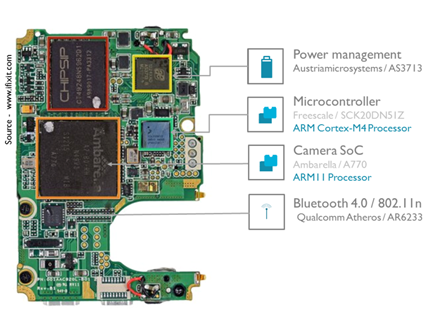 |
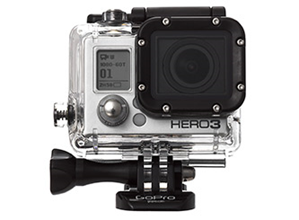 |
GoPro cameras have revolutionised 21st century photography, encouraging people to take their camera with them while partaking in physical and often extreme activities. The product is designed specifically as a camera to capture truly personal photography, and is available with a number of attachments which make it wearable in a variety of circumstances, from mountain climbing through to riding a motorbike. Alongside traditional image capturing, the device can record lengthy videos and also has Bluetooth and WiFi capabilities. It is rugged, small, lightweight and captures high quality images, making it the ideal life logging device.
The HERO3 camera is an example of a device which utilises more than one type of ARM processor on the same chip, with a Cortex-M4 processor used alongside an ARM11 processor. In simple tracking devices, the presence of a Cortex-M series processor for low-power, constant central processing is enough. However, the more functional a device is, the more capable the CPU must be, giving need to a traditional applications processor which can run an OS. The ARM1136J-S processor used inside the HERO3 is a very mature ARM processor, and has since been replaced in GoPro’s newly released HERO4 camera by a dual-core Cortex-A9 processor which runs ARMv7 architecture rather than ARMv6, and delivers higher performance and greater power efficiency at a lower silicon cost. Alongside the ARM11 processor is a Cortex-M4 microcontroller which compiles sensor data as well as processing other small tasks. The finished device represents the ideal solution to on-the-go picture and video logging.
Omate TrueSmart: ARM Cortex-A7 and ARM Mali-400
For an even richer user experience and the complete mobile technology experience, it is now possible to get a fully functional mobile smartphone on your wrist.
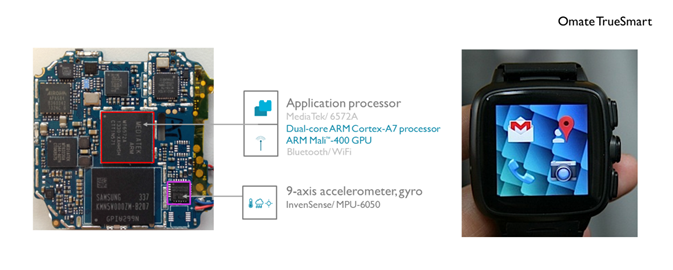
The Omate TrueSmart smartwatch allows users to take calls, reply to messages and even take photos. Apps can be downloaded from the watch’s own app store, meaning the wearer could play a game or update their Facebook status from their wrist. The device represents one of the smallest fully functional smartphone devices, and goes beyond the supplementary requirement of other popular wearables. Omate recently unveiled the Omate X. Powered by an ARM7-based SoC, the Omate X can last for up to seven days between charges, according to the smartwatch manufacturer.
Inside the TrueSmart is a MediaTek 6572A chip, featuring a dual-core ARM Cortex-A7 processor, as well as an ARM Mali-400 GPU. The power of the efficient CPU allows the TrueSmart to run a rich OS, providing users with a wide variety of functionality in a compact form factor. Working alongside the Cortex-A7 is a Mali-400 GPU, which features advanced tile-based deferred rendering and local buffering of intermediate pixel states in order to reduce memory bandwidth overhead and consume less power. The GPU is fully autonomous and has a separate MMU in order to maximise the power-saving from both the CPU and the GPU.
ARM-powered wearable devices have constantly driven innovation across all areas of the market, from the activity tracker to the wearable smartphone. The vast majority of the 19 million wearable devices shipped so far are ARM-powered, creating a huge ecosystem of wearable hardware and software manufacturers with enormous experience in utilising ARM IP. As more devices are released with ARM-based chips inside, the ecosystem is growing, making our processors the only option for engineers.
Keep updated with ARM to find out what devices we are excited about and how we see the future of wearables developing. Join us soon for part two of our wearable review articles when we look at some of the products released at last month’s IFA trade show in Berlin.








